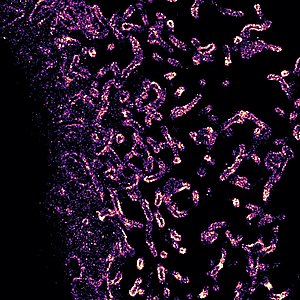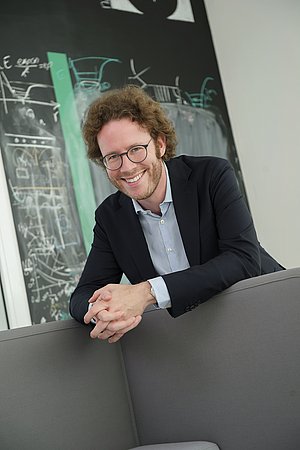Complex sugar structures on the cell surface to shine light on cancer development and immune system regulation
The glycocalyx, a highly complex structure consisting of sugars, surrounds every cell in the body. The molecular organization of the glycocalyx, its response to genetic changes, and how these changes in turn regulate cellular processes are objects of research for Leonhard Möckl, research group leader for Physical Glycosciences at the Max Planck Institute for the Science of Light in Erlangen. He has received three grants totalling around €580,000 for his research projects.

The glycocalyx is the outermost layer at the surface of cells. It can be thought of as an envelope - and indeed glycocalyx means "sweet husk". This coating is the first part of the cell to interact with the environment, for example with other cells, nutrients or pathogens. Leonhard Möckl hypothesizes that the glycocalyx is one of the cornerstones of cell function. In his research, he has already investigated how the glycocalyx drives the development and metastasis of cancer, how it interacts with pathogens and how it is crucially involved in immune system regulation. Thanks to these results and those of other groups, it is now known that glycocalyx is of central importance to the state of the cell. Little is known, however, of how the organization of the glycocalyx at the molecular level impacts these vital processes. It is precisely this relationship between glycocalyx structure and function that Leonhard Möckl wants to understand. The timing of the grants, a DFG grant on "Elucidating the Siglec-sialome axis of immune cell regulation with super-resolution microscopy and single-molecule/-particle tracking", a grant from the Wilhelm Sander Foundation on "Demystifying the interplay between oncogenic events, glycocalyx state, and cellular behavior", as well as additional funding to set up a novel microscopy system, could not come at a better time for the research group leader. The advances in super-resolution microscopy mean the technology is now able to provide the research group leader with insights into glycocalyx organization at a level of detail he has been interested in for years.

In 2010, Leonhard Möckl immersed himself in the world of the glycocalyx while studying at LMU Munich. As he explains, he did so somewhat by chance. “I slipped into the subject a bit. There was an opportunity at the Studienstiftung to participate in scientific colleges. One focus at that time was glycobiology, which I had only heard about in passing during my studies. I was curious, so applied and was accepted – that was the first step.” He quickly developed a fascination for the sugar coat, which had been little researched until then. He also realized: almost no microscopic studies had been carried out linking glycocalyx structure to func- tion. Both during his PhD and at his next stop at Stanford University, Möckl set himself the goal of closing this research gap. Since 2020, he has been a research group leader at the MPL Erlangen.Here, too, the glycocalyx and the study of its architecture remain two of his research foci.
Leonhard Möckl is interested in deciphering the enormous complexity of the sugar structure and its significance to the function of the cells, both in healthy and diseased tissues. In the “sweet coat” on the cell surface, tens of thousands of compounds, from small sugar trees to giant sugar polymers, are densely packed into a tiny space. Thus, previous technologies failed to resolve their precise organization. However, thanks to recent developments in super-resolution microscopy, details are now attainable at the level of individual sugar molecules. "This was the breakthrough I had been awaiting for over ten years" Möckl enthuses. On the one hand, he hopes that these findings will provide entirely new insights into cell function. On the other hand, there is the realistic hope of translating these insights into diagnostic and therapeutic applications, as he explains: “There is almost no cellular process in which the glycocalyx is not somehow involved. If we understand the functional relationship between the state of the glycocalyx and the state of the cell, we immediately obtain new and effective ways to detect diseases. The long-term aim is to derive new therapeutic approaches from this.” Leonhard Möckl has his sights set high, which is why he is now looking for motivated PhD candidates.
Contact:
Dr. Leonhard Möckl
Research group leader ›Physical Glycosciences‹ at the Max Planck Institute for the Science of Light, Erlangen. www.mpl.mpg.de
leonhard.moeckl@mpl.mpg.de
The Möckl Research Group at the Max Planck Institute for the Science of Light is seeking two PhD students for superresolution microscopic studies of the glycocalyx (f/m/d): https://mpl.mpg.de/study-work-or-visit/open-positions
Image 1 (@ Leonhard Möckl): Super-resolved sugars in the glycocalyx on the surface of tubular membrane protrusions.
Image 2 (@ Stephan Spangenberg): Leonhard Möckl, Research group leader ›Physical Glycosciences‹, Max Planck Institute for the Science of Light
Contact
Edda Fischer
Head of Communication and Marketing
Phone: +49 (0)9131 7133 805
MPLpresse@mpl.mpg.de





